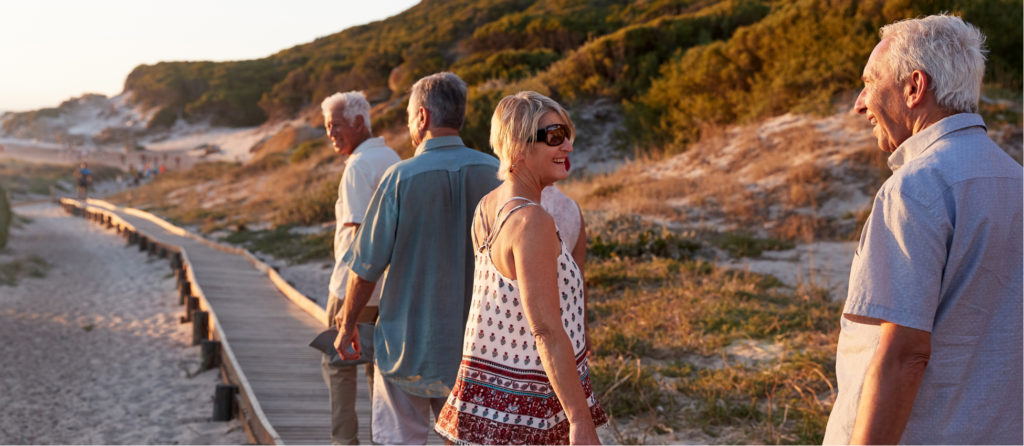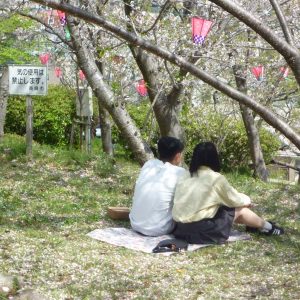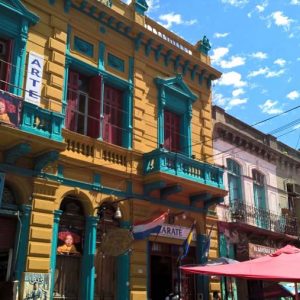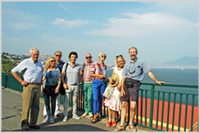 Naples is the capital of Campania, which takes its name from the Roman title of ‘Campania felix’ (fertile countryside). Here in June 2014, I joined a four day press tour of the city and its surroundings, very well organised by Manuella Barzan of the Naples Chamber of Commerce and guided brilliantly by her colleague Duly Peckmann – fertile ground indeed for the enthusiastic Silver Traveller.
Naples is the capital of Campania, which takes its name from the Roman title of ‘Campania felix’ (fertile countryside). Here in June 2014, I joined a four day press tour of the city and its surroundings, very well organised by Manuella Barzan of the Naples Chamber of Commerce and guided brilliantly by her colleague Duly Peckmann – fertile ground indeed for the enthusiastic Silver Traveller.
Castel dell'Ovo (Castle of the Egg), was a most impressive sight, its massive bulk ‘guarding’ the entrance to the port. On a site first settled by the Greeks before 600BC, the poet Virgil is said to have placed, in the first century BC, a ‘magical’ egg into the foundations of the Roman fortress. Breaking of this egg would bring about the destruction of the fortress and downfall of Naples. The 15th century castle, built under Spanish rule, is what survives today – but the egg and the superstition remain!
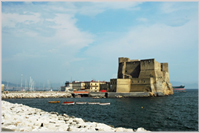 A short walk north of the Castel dell’Ovo, is one of the few traffic-free areas of the city: the grand Piazza del Plebiscito, backed by the impressive, though relatively recent (1816) Basilica Reale San Francesco di Paola. Across the square is the imposing but ugly early 17th century Palazzo Reale di Napoli (Royal Palace), with a special royal passageway to the adjacent Teatro di San Carlo, the oldest opera house in Europe, which opened in 1737. Round the corner is the elegant 19th century shopping arcade and public space of the Galleria Umberto.
A short walk north of the Castel dell’Ovo, is one of the few traffic-free areas of the city: the grand Piazza del Plebiscito, backed by the impressive, though relatively recent (1816) Basilica Reale San Francesco di Paola. Across the square is the imposing but ugly early 17th century Palazzo Reale di Napoli (Royal Palace), with a special royal passageway to the adjacent Teatro di San Carlo, the oldest opera house in Europe, which opened in 1737. Round the corner is the elegant 19th century shopping arcade and public space of the Galleria Umberto.
In the Galleria are found products of one of Naples traditional crafts – the fabrication of coral jewellery and shell cameos by the Ascione Company. Using ethically sourced coral from the Mediterranean and the Sea of Japan, craftsmen produce intricate necklaces, rings, pendants and brooches; many of great beauty.
 Other architectural and artistic gems abound in the historic centre of the city, often hemmed in by more modern buildings, street cafes, market stalls and narrow streets with sauntering shoppers. Perhaps the greatest experience was of the famous statue of the Veiled Christ in the Sansavero Chapel, carved by Giuseppe Sanmartino in 1753 from a single block of marble. The delicacy and apparent transparency of the veil appear miraculous, and show a work of real genius.
Other architectural and artistic gems abound in the historic centre of the city, often hemmed in by more modern buildings, street cafes, market stalls and narrow streets with sauntering shoppers. Perhaps the greatest experience was of the famous statue of the Veiled Christ in the Sansavero Chapel, carved by Giuseppe Sanmartino in 1753 from a single block of marble. The delicacy and apparent transparency of the veil appear miraculous, and show a work of real genius.
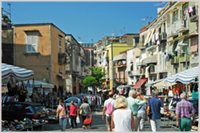 Seven miles to the south-east, Ercolano is a small town with a busting colourful vintage clothing market in its narrow streets. Here all manner of second-hand clothes can be bought, dating back as far as the 18th century. These range from everyday items to luxurious furs and the wedding dresses which, traditionally, must be bought under an arch to signify the passage to a new way of life. It is claimed that designers from the great Italian fashion houses visit the market to glean new ideas from old. In a small courtyard we enjoyed a taste of the excellent frizzante white wine Falanghina Pomeiano, produced by the local Sannino vintner, with delicious Neapolitan Tortano – bread traditionally eaten at Easter and stuffed with Napoli salami, other dried meats, cheese and egg. Completing the experience, local guitarist and composer Giovanni D’Angelo accompanied the beautiful tenor voice of Alfonso in his own songs.
Seven miles to the south-east, Ercolano is a small town with a busting colourful vintage clothing market in its narrow streets. Here all manner of second-hand clothes can be bought, dating back as far as the 18th century. These range from everyday items to luxurious furs and the wedding dresses which, traditionally, must be bought under an arch to signify the passage to a new way of life. It is claimed that designers from the great Italian fashion houses visit the market to glean new ideas from old. In a small courtyard we enjoyed a taste of the excellent frizzante white wine Falanghina Pomeiano, produced by the local Sannino vintner, with delicious Neapolitan Tortano – bread traditionally eaten at Easter and stuffed with Napoli salami, other dried meats, cheese and egg. Completing the experience, local guitarist and composer Giovanni D’Angelo accompanied the beautiful tenor voice of Alfonso in his own songs.
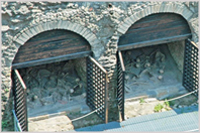 This town, of course, contains buried treasure – ruins of the ancient Roman town of Herculaneum, destroyed by the eruption of Vesuvius in AD 79, of which the greatest part remains hidden under the modern town. Here the erupted ‘pyroclastic’ flow – a ground-hugging mixture of hot gas and rock – had sealed and preserved skeletons and timber, whereas these had decayed over centuries at the much bigger Pompeii. This was typified by the moving sight of skeletons of citizens who had desperately sought shelter in the Boathouse arches by the original shore line; and by the two-storey wine shop, containing original charred wooden shelves with their wine jars intact. The two-storey buildings, the ‘fast-food’ shop, the bakery, the wells and the remains of the aqueduct gave a vivid impression of the daily life of the Roman town.
This town, of course, contains buried treasure – ruins of the ancient Roman town of Herculaneum, destroyed by the eruption of Vesuvius in AD 79, of which the greatest part remains hidden under the modern town. Here the erupted ‘pyroclastic’ flow – a ground-hugging mixture of hot gas and rock – had sealed and preserved skeletons and timber, whereas these had decayed over centuries at the much bigger Pompeii. This was typified by the moving sight of skeletons of citizens who had desperately sought shelter in the Boathouse arches by the original shore line; and by the two-storey wine shop, containing original charred wooden shelves with their wine jars intact. The two-storey buildings, the ‘fast-food’ shop, the bakery, the wells and the remains of the aqueduct gave a vivid impression of the daily life of the Roman town.
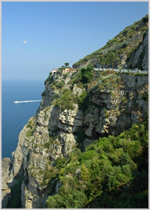 On the following day, we travelled along the coastal road to the Sorrento peninsula, though an area of widespread production of tomatoes, vines, oranges and, especially, lemons – those used in Limoncello production. Then from an area of dramatic limestone cliffs plunging to a lovely deep blue sea, we looked down on Sorrento. At the seaward end is the main resort, from which a zig-zag footpath winds down from a pretty garden to the sea.
On the following day, we travelled along the coastal road to the Sorrento peninsula, though an area of widespread production of tomatoes, vines, oranges and, especially, lemons – those used in Limoncello production. Then from an area of dramatic limestone cliffs plunging to a lovely deep blue sea, we looked down on Sorrento. At the seaward end is the main resort, from which a zig-zag footpath winds down from a pretty garden to the sea.
Disappointingly, this ends in a series of private ‘beaches’ (actually, decks), where sun beds are for hire – the actual area of public beach is very small and correspondingly crowded. However you can walk from here to the port and marina area, allowing a good view of the cliffs with their attractive hotels and villas.
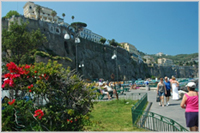 Passing further down the peninsula, a cloudy Capri came into close view on our way to the tiny attractive fishing village of Nerano, where the Lo Scoglio restaurant provided the gastronomic highlight of the whole trip – a lunch prepared by the third generation of a family who set up the restaurant in 1958, based on locally caught fish and vegetables grown on their own farm.
Passing further down the peninsula, a cloudy Capri came into close view on our way to the tiny attractive fishing village of Nerano, where the Lo Scoglio restaurant provided the gastronomic highlight of the whole trip – a lunch prepared by the third generation of a family who set up the restaurant in 1958, based on locally caught fish and vegetables grown on their own farm.
Delicious starters – including crusty bread, broad beans, large tomatoes, aubergine, battered zucchini flowers, mini-calzone, home-made buffalo mozzarella and anchovies – were followed by Sea urchin and Trufo di Mara (Truffle of the sea); spaghetti and zucchini, with coarsely grated parmesan and basil leaf garnish; and spaghetti with baby clams and tomatoes. 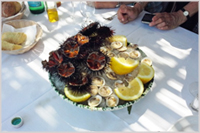 This was accompanied by the well chilled and excellent white wine Falanghina Campania, IGT 2013, by Terredora, and completed by a glass of (very sweet) Limoncello.
This was accompanied by the well chilled and excellent white wine Falanghina Campania, IGT 2013, by Terredora, and completed by a glass of (very sweet) Limoncello.
Though this was regarded as perhaps the best overall meal, other dishes which were particularly enjoyed during the trip included fried calzone with ricotta and smoked provola from 50Kalo (Naples); fried battered cod with red and green peppers from Baccalaria (Naples); octopus with mussel, white asparagus and samphire from Il Ristorantino dell’Avvocato (Naples); and sea bream with lemon slice and lettuce garnish from Rosiello (Posillipo). A real cornucopia of regional tastes rounding off our harvest of delights in Campania!
